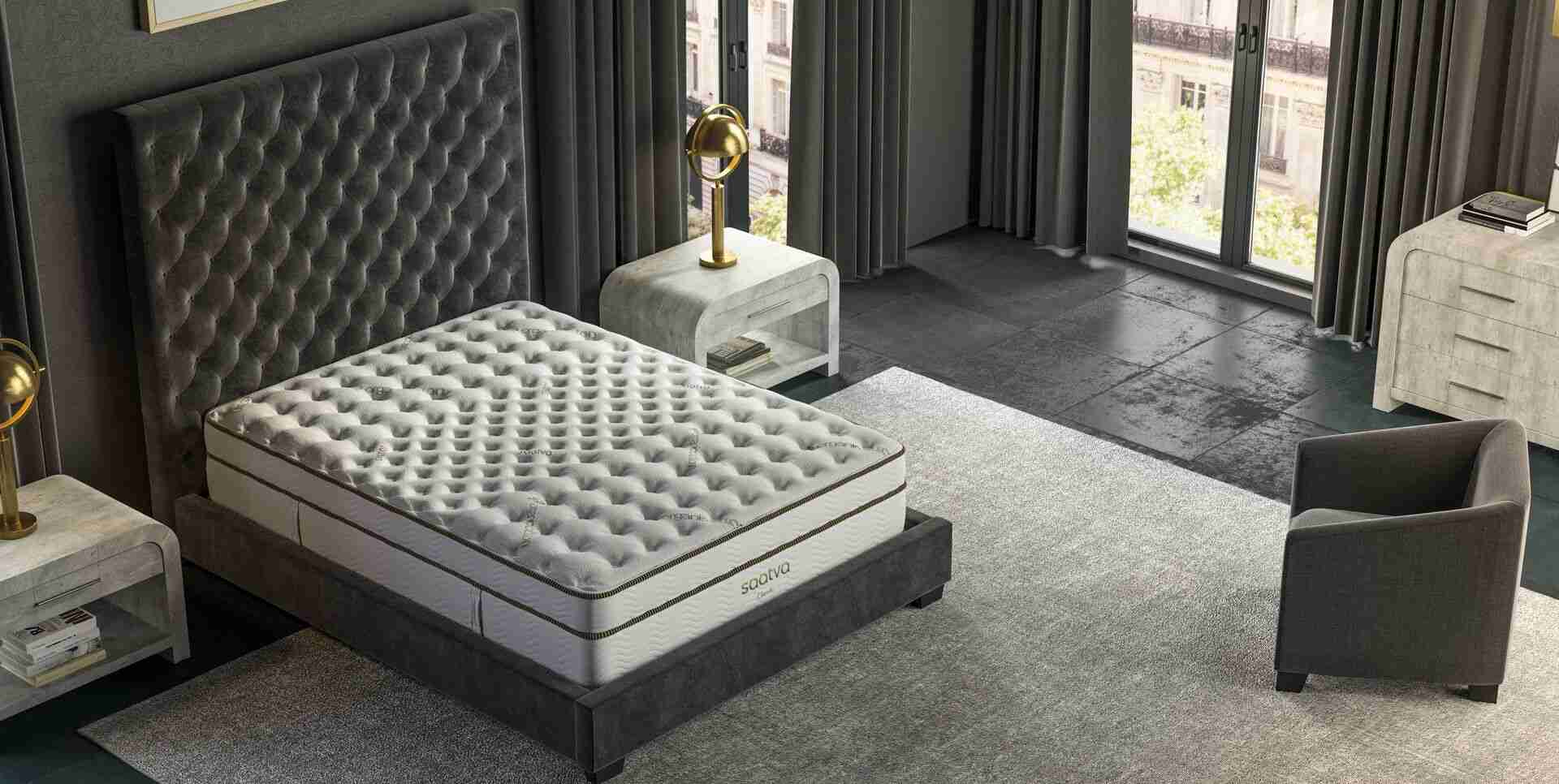With all the news about climate change, many of us want to do our part to protect the environment.
Some of the most obvious ways to go green include cutting out plastic, composting food scraps, and sticking to a mostly plant-based diet. But did you know there are also some easy things you can do in the bedroom to be more sustainable?
Keep reading for the top 10 sustainable habits to adopt in your bedroom right now. You might just improve your sleep in the process!
How to be more sustainable in the bedroom
1. Take advantage of natural lighting
Artificial lighting releases heat, which may cause you to lower your bedroom temperature and use more electricity. It also disrupts your circadian rhythm (known as your sleep-wake cycle).
For these reasons, take advantage of natural lighting. At night, turn off all of your artificial light sources an hour or two before bed to stimulate sleep. This can also help save electricity.
In the morning, allow the sun to wake you up rather than a lamp or alarm clock. This can help make you feel less groggy and ensure you start your day in a good mood.
You can also opt for LED (light-emitting diodes) bulbs, which come with an energy savings of 50%-70%+ compared to other light bulbs.
LED bulbs can last up to 50,000 hours, approximately 25 times longer than halogen bulbs and 10 times longer than other bulbs like fluorescent.
Just keep in mind that LED lighting is still artificial lighting, which can affect your circadian rhythm. So you should continue to turn off your lights before bed.
2. Improve your air quality
No one likes a stuffy nose before bed—but sometimes it’s difficult to avoid when your bedroom is filled with dust, toxins, and pet dander, all of which can cause poor air quality and prevent good sleep.
Luckily, this issue has an easy fix—all it takes is some plants!
Plants do more than add to your room decor. They purify the air by absorbing carbon dioxide and releasing oxygen, and they remove toxins and pollutants that are bad to breathe in.
They also promote better sleep by minimizing your allergies and releasing sleep-inducing scents. The best sleep-promoting plants include lavender, snake plant, and English ivy.
3. Wear eco-friendly sleepwear
According to the World Economic Forum, fashion is the third largest polluter on the planet, accounting for 5% of the world’s greenhouse gas emissions.
It’s the industry’s reliance on nonrenewable synthetic fibers—such as nylon and polyester—that’s largely responsible for these carbon emissions as it takes an estimated 342 million barrels of oil each year to produce them.
Once they’re thrown out, clothes made of synthetic fibers typically end up in a landfill and can stay there for thousands of years since they don’t decompose easily. This creates more plastic waste for the environment.
The solution? Sustainable sleepwear! Examples of greener fabrics include recycled cotton, organic hemp, organic linen, Tencel, and recycled wool.
As a bonus, these materials usually aren’t treated with harmful chemicals, so there’s less of a chance they’ll irritate your skin. They’re also usually higher quality, which means they’ll last longer so you can cut down on waste.
Plus, choosing organic, Fair Trade, and certified ethically-made clothing ensures humans were treated fairly and not harmed in the production process.
Editor’s note: We know sustainable sleepwear can get pricey since you’re paying for the quality and ethical practices.
A cheaper alternative is using old T-shirts and bottoms or thrifting clothes comfortable to sleep in. That way, you keep old clothes out of landfills and reduce your carbon footprint!
4. …or go naked
We’ve talked about the many health benefits of sleeping naked—but did you know it’s also eco-friendly?
The average residential washing machine uses an estimated 41 gallons of water per load, while a dryer accounts for about 6% of the average home’s energy use.
Sleeping naked equates to less laundry, and less laundry means less water and energy use.
5. Unplug your electronics
Standby power is power used by unused but plugged-in devices—and according to the U.S. Department of Energy, it’s responsible for 5%-10% of residential energy use.
What’s more, the cost of standby power is approximately $19 billion annually—and it emits a whopping 44 million tons of carbon.
So start unplugging your electronics before bed. Doing this can help your household save up to $100 per year, cut down on energy use, and increase the lifespan of your devices.
It can get tedious to unplug every single plug in your room each night, so choose your least commonly used electronics and unplug those.
Also, take advantage of power strips to make the process easier and quicker (especially for plugs in hard-to-reach places).
6. Make your own cleaning products
Cleaning your bedroom frequently is vital for good sleep hygiene and your physical and mental well-being. However, popular cleaning products can do more harm than good when they contain toxic ingredients and chemicals.
According to the U.S. Environmental Protection Agency (EPA), chemicals in cleaning products are associated with eye, skin, or respiratory irritation (such as burning hands and nostrils).
Volatile organic compounds (VOC) in cleaning products can lead to poor indoor air quality and contribute to smog formation outside.
Instead of depending on harmful cleaning products, take a DIY approach. Use ingredients like white vinegar, baking soda, lemon, and essential oils, which are inexpensive, nontoxic, and effective.
Also, opt for reusable bottles and washcloths to minimize your waste!
If you’re not into the whole DIY thing, you can still use store-bought cleaning products—just make sure they’re eco-friendly cleaners that are safe for your home (and your pets!). To do so, look for EPA and Green Seal labels on the packaging.
7. Thrift for decor
Who doesn’t love cute bedroom decor? These items can make your bedroom look good and help you sleep better.
But it can get expensive to redecorate—and it’s not exactly eco-friendly to buy new stuff every season. After all, it takes a whole lot of energy and resources to create new home goods.
Instead, head to your local thrift store the next time you’re ready for a bedroom refresh. By thrifting, you’re choosing to buy items that didn’t involve using any new resources and energy. You’re also potentially saving something from ending up in a landfill. (Here are tips for thrifting furniture for the bedroom.)
8. Use eco-friendly heating and cooling systems
According to the Proceedings of the National Academy of Sciences, approximately 20% of U.S. energy-related greenhouse gas emissions stem from heating, cooling, and powering households.
Our carbon footprint is only increasing the amount of excessive heat in our atmosphere, which leads us to depend even more on our cooling systems.
Turning to eco-friendly insulation and a green HVAC system can help reduce your carbon emissions.
Poor insulation will promote heat flow within your house—and synthetic insulation often contains polyurethane, flame retardants, asbestos, VOCs, or formaldehyde, which are all health hazards.
When choosing insulation for your home, search for Greenguard-certified insulation materials, such as cotton, sheep’s wool, and hemp.
Besides insulation, opting for a new HVAC system or greener alternatives can help reduce your energy use.
Older HVAC systems are less energy-efficient, more likely to break down or need repairs, can increase energy bills, and aren’t eco-friendly. Some may even contain refrigerants that are no longer certified.
Newer models, on the other hand, can help save energy and money and minimize the release of hydrofluorocarbons (HFCs), chemicals used for cooling, in the air.
You can also choose a greener alternative, such as solar power, biomass, or geothermal heat pumps.
As a result, a well-insulated home and a good HVAC system can reduce heat flow, be more energy-efficient when heating or cooling your home, save you money, and help you sleep comfortably at night.
9. Recycle old mattresses and bedding
Americans throw out an estimated 20 million mattresses and box springs every year, and most of them end up in landfills.
They also get rid of 21 billion pounds of textiles every year, which is roughly 5% of all the waste generated in the country, according to the Council for Textile Recycling. This waste ends up emitting greenhouse gasses as it accumulates in landfills.
Instead of contributing to this problem, repurpose your old mattresses and bedding by giving them a new home or getting crafty with their materials.
A few fun and easy ways to give these bedroom items new life include:
- Making a pet bed with your old pillow
- Using an old sheet as a picnic blanket
- Creating plant holders with coils from an old mattress
- Making sleepwear with old sheets
- Cutting up cleaning rags with old pillow fabric
Besides creating new products out of your old things, you can also look into donating them. (Here’s how to embrace a zero-waste lifestyle in the bedroom.)
10. Sleep on an eco-friendly mattress and bedding
After you’ve repurposed your old mattress and bedding, now it’s time for a new mattress, pillows, sheets, and more! But it’s important to choose the right mattress and bedding if you want to live more sustainably.
Non-eco-friendly mattresses use chemicals, such as petroleum-based polyurethane foam, toxic fire retardants, chemical adhesives, pesticides, and VOCs that can cause skin irritation or allergies.
Similarly, pillows can also contain harmful chemicals like flame retardants and VOCs, which can off-gas. Some may even include perfumes and deodorizers to mask the off-gassing emissions.
Sheets that are marketed as “wrinkle-free” are typically finished with a chemical process that uses formaldehyde, which can lead to skin irritation and respiratory issues.
For these reasons, choose a sustainable mattress and hypoallergenic bedding that are free of harmful chemicals.
Here at Saatva, we’re committed to bringing you sleep products that are good for the environment—and your health.
Some of the top ways we support the environment are by:
- Using eco-friendly foams in our mattresses
- Having mattress covers made with breathable organic cotton
- Making our innerspring coils out of recycled steel
- Harvesting our latex sustainably
- Relying on natural flame retardants
Aside from producing green mattresses and bedding, we minimize our carbon footprint by manufacturing our mattresses in America. Additionally, our flagship factory in New Jersey is solar-powered.
In short, we pride ourselves in using natural, nontoxic materials that make our products long-lasting, durable, comfortable to sleep on, and safe to sleep with.
FAQs
How can I be more sustainable at home?
There are various ways you can be more sustainable at home. These include unplugging your unused devices, sleeping naked, thrifting for decor, and making your own cleaning products.
Additionally, sleeping on an eco-friendly mattress and bedding can be healthier for you and help reduce your carbon footprint.
Want more advice for creating a sustainable bedroom? Check out these eco-friendly design tips for inspiration.







